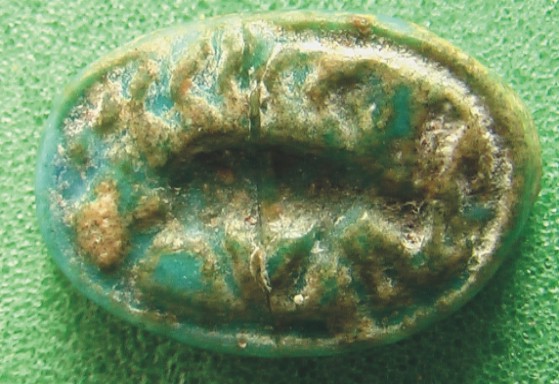W1155a
W1155a A long eared hedgehog ring bezel? A centipede? Or a gazelle?

W1155a is a faience ring bezel (the decorative piece of the ring), which resides in the Egypt Centre. It seems to have come from the British Museum in 1978 with a box of ring bezels from Amarna, one of which includes a bezel of a lute player (Bosse-Griffiths 1980). It probably shows a gazelle.
It bears a strong resemblance to that published in Frankfort and Pendelbury (1933, 115, pl. XLIX I.D.II), and indeed its unusual character makes it probable that this is the very bezel. Such a bezel is listed as coming from the ‘Coronation Hall’ (‘Smenkare Hall’) to the south west of the Great Palace of the Central City (City of Akhenaten III, 85).
But, what is it? It was originally catalogued as a centipede. The resemblence to a centipede may be seen if the artefact is held upside down. However, this way round it looks more like a hedgehog with four legs and two long ears. The length of the legs is similar to that depicted on some amulets (e.g. Andrews 1994, fig. 54).
No other hedgehog bezels are listed in either Pendlebury (1933) or Frankfort and Pendlebury (1951). It is unlikely to have been excavated prior to 1926 as it is listed as ‘a new type’ in Frankfort and Pendelbury (1933, 115). Stevens (2006, 59) briefly discusses a hedgehog scaraboid published by Petrie (1894, pl. XV.152) from Amarna.
The most extensive published study of the hedgehog in ancient Egypt is that by von Droste zu Hülshoff, V (1980). The hedgehog appears in Old Kingdom tomb reliefs in desert scenes, as heads on solar barques, as offerings and there are also clay vessels in hedgehog shape. From the Middle Kingdom the hedgehog features on scaraboid amulets and later in the famous aryballoi which feature in many Egyptian collections and seem to have been exported throughout the Mediterranean World (see Webb 1975 for a full treatment of these items). It has a solar significance (shown by appearance on solar barques), and is protective as it attacks ‘bad’ animals such as snakes. Its ability to survive the desert also lends it protective qualities. Hedgehog is included in recipes in New Kingdom P. Ebers and other medical documents and the hedgehog is a symbol for the goddess Iusaâs/ Âbâs of the Bahariya Oasis. Hedgehogs may have been used as offerings in the season of peret as a symbol of resurrection, or as a means of protecting the sun god.
Finally, Aufrère and Erroux-Morfin (2001) outline a suggestion that the hedgehog aryballs of the Late Period (most are of 26th Dynasty and many seem to have been traded from Naukratis) may have contained extracts of hedgehog spines and other body parts, which were used as a remedy against hair-loss. Such remedies not only occur in ancient Egyptian texts but also in various oriental recipes of the present day.
However, looked at another way, the object may in fact be a badly executed gazelle and the ‘spines’ of the hedgehog actually a palm branch representing rnp, meaning to be youthful, invoking newness and vigour. As Strandberg (2009, 158-159) states, the gazelle is a feminine solar-daughter symbol, as well as a symbol of rejuvenation. Gazelles are shown in association with the royal princesses at Amarna, possibly as pets. They are possibly shown on the wall of the tomb of Meryre II (Davies 1905, 39, pl. XXXVII; Strandberg 2009, 30). Gazelle ring bezels are common at Amarna (we have one in the Egypt Centre) and some appear with the rnp branch (e.g. Stevens 2006, 58, fig. II.2.27).
References
Andrews, C. 1994. Amulets of Ancient Egypt. London: British Museum Press.
Aufrère, S.H. and Erroux-Morfin, M. 2001. Au sujet du hérisson. Aryballes et preparations magiques à base d’extraits tires de cet animal. In Aufrère, S.H. ed. Encyclopédie religieuse de l’Univers végétal Croyances phytoreligieuses de l’Égypte ancienne II, 521-533.
Bosse-Griffiths, K. 1980. Two Lute-players of the Amarna era. Journal of Egyptian Archaeology 66, 70-82.
Davies, N. de G. 2005. The Rock cut tombs of El Amarna II. The tombs of Panehesy and Meryra. London: EEF.
von Droste zu Hülshoff, V. 1980. Der Igel im alten Ägypten. Hildesheimer Ägyptologische Beiträge 11. Hildesheim: Gernstenberger.
Frankfort, H. and Pendlebury, J.D.S. 1933. The City of Akhenaten Part II. The North suburbs and desert Altars. The excavations at Tell el-Amarna during the seasons 1926-1932. London: Egypt Exploration Society.
Pendlebury, J.D.S. 1951. The City of Akhenaten Part III, Volume I Text. The Central City and The Official Quarters. The excavations at Tell el-Amarna during the seasons 1926-1927 and 1931-1936. London: Egypt Exploration Society.
Petrie, W.M.F. 1894. Tell el Amarna, Warminster.
Stevens, A. 2006. Private Religion at Amarna. The Material Evidence. BAR International Series 1587. Oxford: Archeopress.
Strandberg, Å 2009. The Gazelle in Ancient Egyptian Art: Image and Meaning. Uppsala: Uppsala University.
Webb, V. 1978. Archaic Greek faience: miniature scent bottles and related objects from East Greece, 650-500 B.C. Warminster, England: Aris and Phillips.
Other objects from Amarna in the Egypt Centre